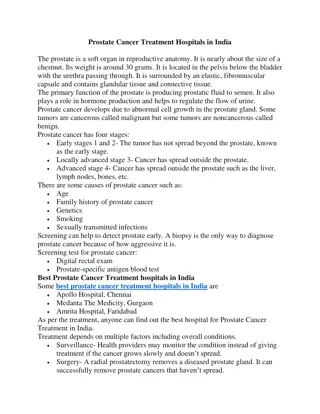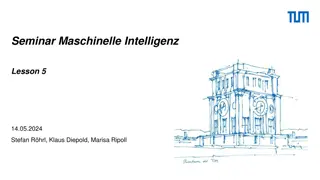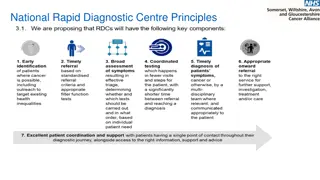Prostate Collaborative Group Research Efforts Overview
The Prostate Collaborative Group is actively working on various research projects related to the detection and evaluation of prostate cancer biomarkers. Updates on research statuses, innovative imaging and urine testing methods, development of protein biomarkers, and biomarkers for early detection of aggressive prostate cancer are highlighted. The group aims to enhance the diagnosis, treatment, and monitoring of prostate cancer through cutting-edge technologies and collaborative efforts among leading experts in the field.
Download Presentation

Please find below an Image/Link to download the presentation.
The content on the website is provided AS IS for your information and personal use only. It may not be sold, licensed, or shared on other websites without obtaining consent from the author. Download presentation by click this link. If you encounter any issues during the download, it is possible that the publisher has removed the file from their server.
E N D
Presentation Transcript
Session Objectives Updates of the Status of Research Effort Evaluation of Biomarker Development Status
Imaging and Urine Testing to Enhance Prostate Cancer Detection Martin Sanda, M.D., Emory University. CVC Screening to reduce unnecessary biopsy Post-DRE urine based RNA detection Phi-PCA3 (in clinical use) T2Erg, ready for validation 6 months Post-DRE urine EV transcriptome (Discovery) Detection of micromets using FACBC-PET imaging. This project is in patient/scan recruitment phase MiPS and Next Generation MiPS for Prostate Cancer Detection Arul Chinnaiyan, M.D., Ph.D., University of Michigan. BDL PCA3 FDA approved Facilitating the clinical utilization (CLIA/CAP) of MiPS (PCA3 + T2-ERG) and enhancing performance via Next Gen MiPS. New discovery in lnc/circRNAs to improve performance. Multi-parametric assays, high-throughput methods for urine analysis. 6 selection and optimization and 12 months validation
Development of Protein Biomarkers in Post-DRE Urine for use in Liquid Biopsy of Prostate Cancer BDL O. John Semmes, Ph.D., Eastern Virginia Medical School Paul Boutros, Ph.D., M.B.A., University of California, Los Angeles Thomas Kislinger, Ph.D., Princess Margaret Cancer Centre, University Health Network, University of Toronto Identification of aggressive disease in the context of Organ-confined versus Non-Organ-Confined Disease, Active Surveillance, Relapse. Post-DRE urine and tissue-based Relapse after definitive treatment, tissue-based biomarkers, ready for validation in 6 months. Urine-based biomarkers 6 months selection of panels, 1 year ready for validation. Fucosylated and Urinary Glycoprotein Biomarkers for Aggressive Prostate Cancer BDL Hui Zhang, Ph.D., Johns Hopkins University Ruedi Aebersold, Ph.D., Institute of Molecular Systems Biology, ETH Zurich SWATH tissue-based proteomics Post-DRE urine Urine glycoproteomics TMA and Lectin-ELISA platform for validation Targeted tissue based biomarkers verification 6 months, validation 12 months
Biomarkers for Early Detection of Aggressive Prostate Cancer. PNNL Tao Liu, Ph.D. and Karin Rodland, Ph.D., Pacific Northwest National Laboratory Risk assessment at initial biopsy, progression. Target protein biomarker list of PCa -associated genes Tissue based biomarker performed well with RP moving to biopsy, procuring samples for analytical validation Tissue-Informed Biomarker Discovery in Urine Exosomes from African American and Caucasian American Men under Suspicion for Prostate Cancer CPDR Jennifer Cullen, Ph.D., Center for Prostate Disease Research, Uniformed Services University of the Health Sciences and the Walter Reed National Military Medical Center Tissue-based discovery to identify potential RNA biomarkers that present in urine exosomes. 6+ marker panel at biopsy and monitoring AS, in development Patient population biased toward AA recruitment, expanding cohort size to power AA
Development of an In Vitro Diagnostic Multivariate Index Assays (IVDMIA) for Aggressive Prostate Cancer. BRL Daniel Chan, Ph.D., Johns Hopkins University Develop a panel of biomarkers to identify aggressive prostate cancer into a multivariate panel IVDMIA Luminex platform Established PSA isoforms Fucosylated PSA (Zhang JHU BDL) sTIE-2 (soluble angiopoietin-2) Literature-derived markers Ready for verification in 6 months
Imaging Biomarkers in Prostate Cancer Yoga Balagurunathan, Ph.D., John Heine, Ph.D., Robert Gillies Ph.D., and Matthew Schabath, Ph.D., H. Lee Moffitt Cancer Center and Research Institute, Inc. CVC Radiologic imaging to tackle the heterogenous nature of tumors. Feature-based risk model (redundancy reduction slide) Initial patient cohort suggests discrimination between GS<6 from GS>8 Evaluate radiomics at biopsy EDRN PRE/VALIDATION STUDIES: Prostate-MRI Study John Wei, M.D., University of Michigan Net benefit of MRI/Fusion biopsy over standard of care MRI as initial biopsy yields <10% benefit Slides, tissue prints and post-DRE urine (and pre-DRE urine) Recruitment and collection has begun. Samples should drive tests prior to MRI and present value added. Predict need for MRI and/or add to MRI.
The Tissue Upgrading Study (URS Study) Robin Leach, Ph.D., The University of Texas Health Science Center, San Antonio Martin Sanda, M.D., Emory University Jackie Dahlgren, B.S., Fred Hutchinson Cancer Research Center Identify presence of Gleason 7 in men that present 3+3 at biopsy Target recruitment size was 240 with 200 completing process; currently at 196 Reassessment of completion rate suggests that serum is on target, Post-DRE urine will require extension of efforts. Planned follow-up discussion.
























